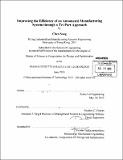| dc.contributor.advisor | Stephen C. Graves. | en_US |
| dc.contributor.author | Song, Chen, S.M. Massachusetts Institute of Technology | en_US |
| dc.contributor.other | Massachusetts Institute of Technology. Computation for Design and Optimization Program. | en_US |
| dc.date.accessioned | 2013-11-18T19:20:19Z | |
| dc.date.available | 2013-11-18T19:20:19Z | |
| dc.date.copyright | 2013 | en_US |
| dc.date.issued | 2013 | en_US |
| dc.identifier.uri | http://hdl.handle.net/1721.1/82416 | |
| dc.description | Thesis (S.M.)--Massachusetts Institute of Technology, Computation for Design and Optimization Program, 2013. | en_US |
| dc.description | Cataloged from PDF version of thesis. | en_US |
| dc.description | Includes bibliographical references (p. 71-72). | en_US |
| dc.description.abstract | This research investigates a complex automated manufacturing system at three levels to improve its efficiency. In the system there are parallel loops of stations connected by a single closed conveyor. In each loop there are a series of identical stations, each with multiple storage slots and with capability to process several jobs simultaneously. At the system level we undertake capacity planning and explore Work-in-Process (WIP) control. We build an Excel model to calculate the implied load of each station, applying the model to sensitivity analyses of the system capacity. In addition, we identify a concave relationship between output and WIP based on actual factory data from our industrial partner. We surprisingly observe a reduction in output when WIP is high. Therefore, we suggest adopting a CONWIP policy in the system in order to increase and smooth the output. At the loop level we study the assignment policy. The complexity of this study is highlighted by non-trivial travel time between stations. We build a simulation model in Matlab to compare different assignment policies. The objective is to find the assignment policy that balances the station load, decreases the flow time for jobs, and reduces the rejection or blockage rate for the system. At the station level we investigate the holding time between simultaneous processes. We model this as a semi-Markov process, building a simulation model in Matlab to confirm the analytical results. We discover a tradeoff between flow time and production rate with different holding times, and propose new holding rules to further improve station performance. The conclusions from this research are useful for our industrial partner in its efforts to improve the operation of the system and to increase its capacity. Moreover, the methodologies and insights of this work can be beneficial to further research on related industry practice. | en_US |
| dc.description.statementofresponsibility | by Chen Song. | en_US |
| dc.format.extent | 84 p. | en_US |
| dc.language.iso | eng | en_US |
| dc.publisher | Massachusetts Institute of Technology | en_US |
| dc.rights | M.I.T. theses are protected by
copyright. They may be viewed from this source for any purpose, but
reproduction or distribution in any format is prohibited without written
permission. See provided URL for inquiries about permission. | en_US |
| dc.rights.uri | http://dspace.mit.edu/handle/1721.1/7582 | en_US |
| dc.subject | Computation for Design and Optimization Program. | en_US |
| dc.title | Improving the efficiency of an automated manufacturing system through a tri-part approach | en_US |
| dc.type | Thesis | en_US |
| dc.description.degree | S.M. | en_US |
| dc.contributor.department | Massachusetts Institute of Technology. Computation for Design and Optimization Program | |
| dc.identifier.oclc | 862814162 | en_US |
